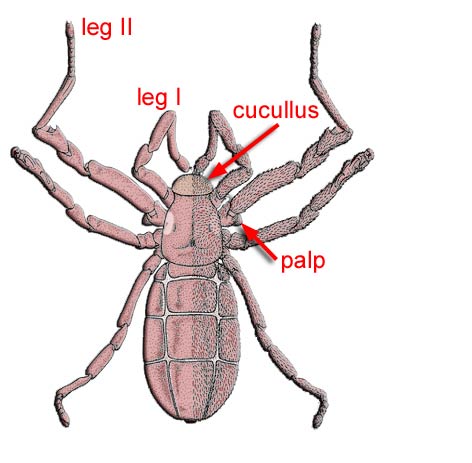| |
-
Ricinuleida (Ricinulei)
Common names:
ricinuleids
Probability of
encounter: low
Quarantine importance:
no known importance, although of potential conservation concern as threatened
cave or rainforest dwelling species.
Similarity to mites:
hexapod larvae, gnathosoma, more or less mite-like build; however, ricinuleids
have opisthosomas with three series of dorsal sclerites and clear ventral
segmentation.

Morphology
- Normal adult
length: <10 mm
Body tagmata: gnathosoma, prosoma, idiosoma
Eyes: lens absent (pigment spot may be present)
Antennae: absent
Mouthparts: 2-segmented chelicerae; long, elbowed palps
Legs: 4 pairs (3 pairs in larvae); tarsi I & II with sensory pits
Distinguishing features: cucullus (shelf over mouthparts), elbowed
palps, postabdomen
-
Comments:
Ricinuleids and mites (Acari) are the only arthropods with a capitulum, i.e.
with the cheliceral and pedipalpal segments separated from the remainder of
the prosoma by a circumcapitular groove.
Diversity: 1 family (Ricinoididae),
3 geographically +/- discrete genera (Brazil to Honduras: Cryptocellus; Panama to Texas:
Pseudocellus; Africa: Ricinoides), >55 spp.
-
References
-
- Harvey, M.S. 2003. Catalogue of the smaller
arachnid orders of the World. CSIRO Publishing, Collingwood, Victoria
